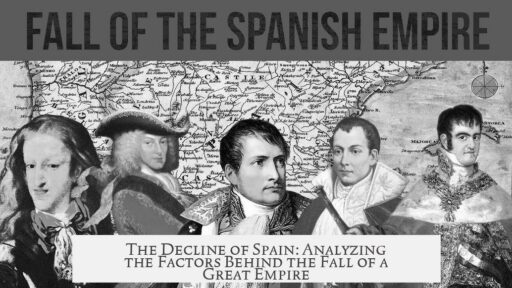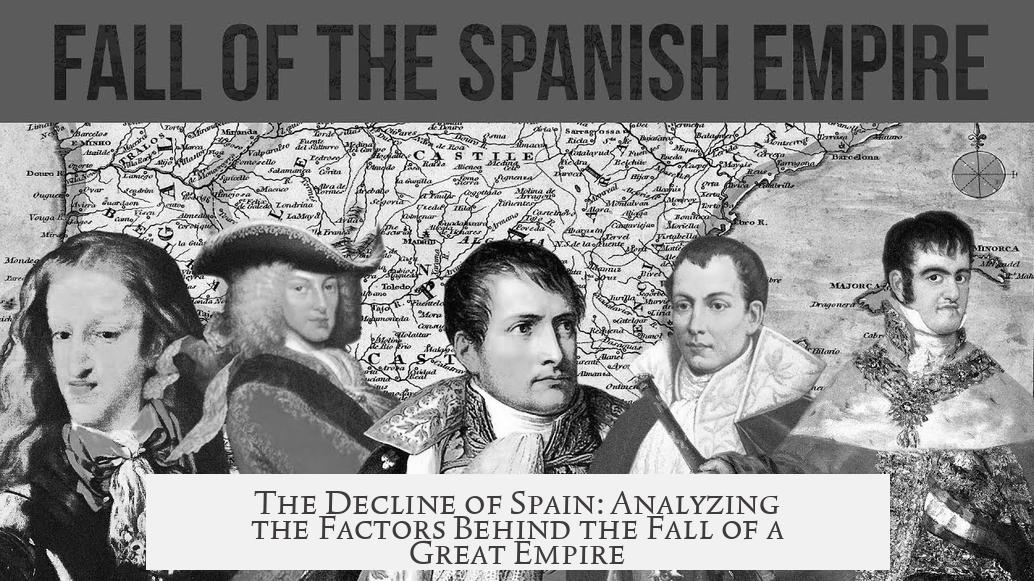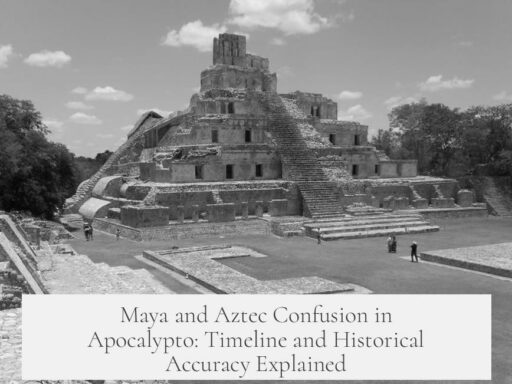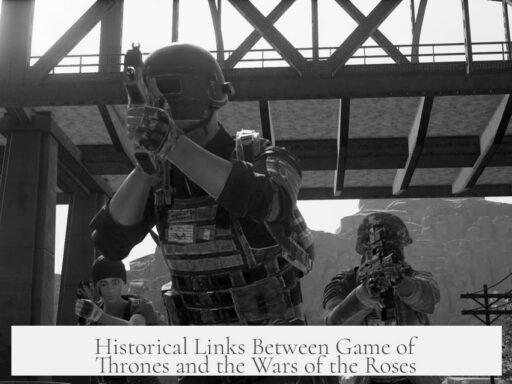Spain fell hard due to a combination of early military defeats, economic mismanagement, internal conflicts, and structural weaknesses that spanned centuries. Its decline began well before the 19th century, rooted in wars, failed policies, and social divisions.
Spain’s decline starts in the mid-16th century and worsens over the 17th century. The Eighty Years’ War severely weakened Spain, bankrupting it multiple times. Losing this war exposed Spain’s diminishing power. Soon after, the Franco-Spanish War drained resources further. Simultaneously, internal revolts in Catalonia and Portugal, the latter winning independence, fragmented its control. Spain fought several major wars on multiple fronts, overwhelming its capacity.
The Spanish economy faltered due to over-reliance on American gold and silver. This inflow led to inflation and discouraged industrial development. Spain didn’t build a sustainable economy because it focused on extracting wealth from colonies instead of fostering domestic trade or industry. This created corruption, as elites bribed officials to secure shares of wealth. Additionally, the expulsion or persecution of Jews and Muslims eliminated key artisan and trader groups, damaging the economic base further.
Spain’s composite monarchy complicated matters. The empire consisted of separate kingdoms like Castille, Aragon, and Navarre, each with different systems. Castille bore the taxation burden but was forced toward sheep herding over agriculture. This hurt food production and increased reliance on imports. Charles V borrowed heavily from foreign bankers, increasing dependence on external capital.
Trade was strictly controlled. The Casa de Contratación monopolized Atlantic trade through Seville, banning inter-colonies commerce and forbidding colonies from manufacturing essential goods. This stifled economic flexibility and innovation.
The Bourbon dynasty of the 18th century introduced some reforms, centralizing power and modernizing administration. They liberalized trade restrictions in the Americas, founded new viceroyalties, and upgraded the navy. However, Spain remained weak industrially, lacked a middle class, and suffered capital shortages due to inflation and economic distress.
Spain’s foreign policy aligned heavily with France after the Bourbons took power. This drew Spain into costly conflicts like the Seven Years’ War, where Britain captured key territories including the Philippines and Cuba. The Napoleonic Wars further destabilized Spain, as Napoleon’s invasion led to a national crisis and the eventual loss of many American colonies.
Internal divisions deepened with revolts such as the Carlist Wars, pitting liberals against conservatives. These conflicts weakened Spanish unity and drained resources. Regionalism persisted, with Catalonia, the Basque Country, and others maintaining significant autonomy under the fueros system. This fragmented governance made consistent reforms difficult.
Spain’s military strength deteriorated over time. Its loss of naval supremacy began with the failed Armada in 1588 and was sealed by the defeat at Trafalgar in 1805. These defeats allowed Britain to dominate the seas and limit Spain’s ability to protect its colonies and trade.
The country’s political system was extractive, concentrating wealth and power among the monarchy and elites while failing to build institutions supporting broad economic growth. Bureaucracy became complex and corrupt, ineffective without strong leadership.
| Factor | Impact |
|---|---|
| Military Conflicts (Eighty Years’ & Franco-Spanish Wars) | Bankrupted Spain, lost territories, exposed weakness |
| Economic Over-dependence on American Silver | Inflation, lack of industrial growth, corruption |
| Internal Revolts and Regionalism | Divided Spain, weakened central authority |
| Restrictive Trade Policies | Hampered colonial economic development |
| Loss of Naval Dominance | Naval defeats led to loss of global influence |
| Extractive Political System and Bureaucracy | Concentrated power, stifled reform, increased corruption |
| Failure to Industrialize | Left Spain behind European rivals in economic modernization |
- Spain’s decline began centuries before its American wars of independence.
- Continuous wars drained resources and fractured the empire.
- Economic policies prioritized silver extraction, causing inflation and stagnation.
- Internal fragmentation and revolts undermined central authority.
- Bourbon reforms brought changes but couldn’t reverse structural weaknesses.
- Naval defeats ended Spain’s global maritime supremacy.
- An extractive political system blocked institutional and economic progress.
How did Spain fall so hard?

Spain’s fall was a long, complex tumble that didn’t just happen overnight but unfolded over centuries. It began its decline in the mid-16th century, crippled by constant wars, economic mismanagement, internal strife, and a string of misguided policies. From military overreach and inflation to monopolistic colonial controls and internal revolts, the downfall was rooted deep in structural weaknesses.
But why exactly did one of the world’s greatest empires stumble so spectacularly? Let’s unspool this tangled story by diving into key moments and forces that led Spain from glory to decline.
Early Decline: The Seeds of Weakness (Mid-16th to 17th Century)
By the mid-1500s, Spain was already displaying cracks in its imperial armor. Contrary to popular belief, the fall didn’t start with the 1898 Spanish-American War but much earlier. It was a gradual weakening that stretched through the 16th and 17th centuries.
One of the biggest blows came from the Eighty Years’ War, or the Dutch War of Independence. Spain wasn’t just fighting to maintain control but bleeding its treasury dry. Multiple bankruptcies hit the crown, signaling to the world that Spain’s grip was loosening. Financially spent and militarily overextended, Spain was no longer the invincible colossus it once seemed.
Right on the heels of that war came the Franco-Spanish War and several internal revolts. Trouble wasn’t just external; Catalonia and Portugal seized the moment to rebel. Portugal’s independence was a particularly harsh defeat, as it tore away one of Spain’s key domains. Suddenly, Spain was juggling wars on several fronts—biting off more than it could chew.
The Curse of Over-reliance on American Gold and Silver
Spain’s economic policies were like living on a sugar rush—thanks to the piles of gold and silver streaming in from the Americas, Spain became complacent. Rather than building a diverse industrial economy, Spain leaned on its natural resource wealth. This, unfortunately, mirrored the classic “resource curse.”
Everyone scrambled to grab a share of the treasure rather than innovate or expand trade and industry. The result? Rampant corruption. Investors funnelled money into bribery to secure their piece of the colonial pie instead of productive ventures. The economic engine sputtered, not from a lack of resources but from systemic shortsightedness.
Devastating Social and Economic Impact of the Expulsion of Jews and Muslims
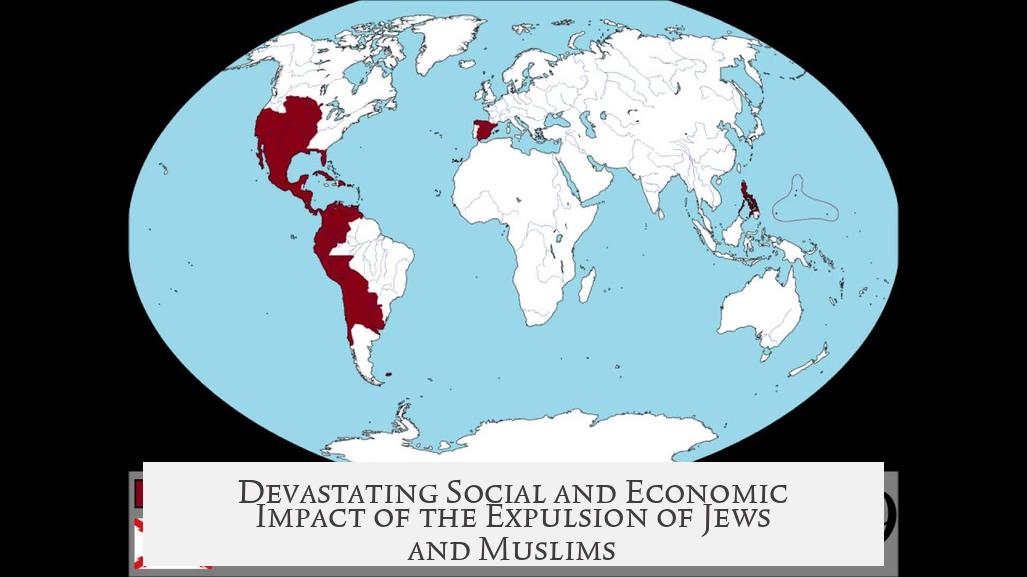
By pushing out and persecuting Jews and Muslims, many of whom were artisans, traders, and economic masterminds, Spain gutted a vital layer of its economic structure. This mass exodus deprived the country of skills and networks essential for commerce and manufacturing. The economy’s hands were tied, missing the dexterity only diversity and tolerance can bring.
Habsburg Spain: Inheritance That Was More a Burden
Spain’s great empire initially formed through inheritance—Charles V collected an empire spanning Spain, the Low Countries, Italy, and the Americas.
Yet it was a patchwork, more than a unified state: kingdoms like Castille, Aragon, and Navarre retained autonomy, each with their own rules. Castille, blessed with American riches, became the financial backbone, but bearing most of the tax burden bred resentment and economic inefficiencies. Instead of fostering a balanced economy, Castille was turned into a “cash cow.”
Charles’s reliance on foreign bankers, especially Germans, further drained Spain’s autonomy. Massive loans financed wars and partnerships, such as with Genoa’s navy, to counter Ottoman expansion. But this foreign dependency planted long-term financial vulnerability.
Restrictive Colonial Trade Policies: Controlling the Flow to a Fault
Spain’s colonial trade was strangled by tight controls. The Casa de Contratación held the monopoly over trade to and from the Americas via Seville. The colonies couldn’t trade among themselves, forced to buy sailing equipment and goods only from Spain.
This rigid system throttled economic growth and innovation in the colonies. Need new maps or trade info? Pay the Casa. Want to diversify your trade routes? Sorry, you’re stuck with Seville.
Internal Turmoil and Corruption: The Empire’s Decay from Within
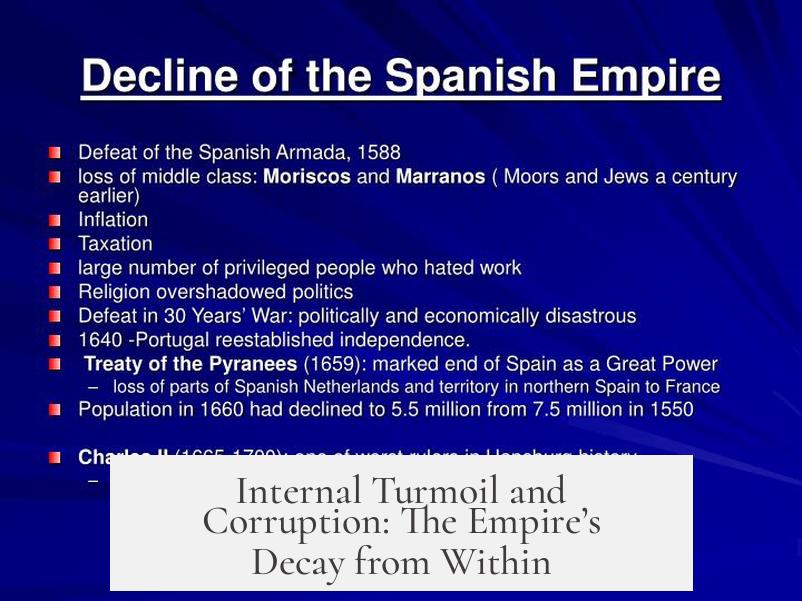
Corruption blossomed as Spain tried to centralize power. Figures like Lerma and Olivares made grand plans to unite the kingdoms, but internal weaknesses and favoritism stalled reform. The Catalan and Portuguese revolts in the 1640s exemplified the empire’s fragile hold. With Spain involved in the Thirty Years’ War, it was forced to acknowledge Dutch independence in 1648—yet another loss that chipped away its global stature.
The Bourbon Interlude: Reform Without Strength
When the Bourbons took over in the 18th century, things improved, but the wounds ran too deep. Philip V abolished some scattered regional states and centralized power somewhat. Navarra, a loyal supporter, kept certain autonomous rights.
Still, Spain continued to lack a vital middle class and had a weak industrial base. Inflation—fueled by silver hoards—remained rampant. Efforts to modernize the Navy and trade in the Americas happened, but tensions with local colonial elites (criollos) brewed, foreshadowing rebellion.
Loyalty to France dragged Spain into more global conflicts on the wrong side. Spain lost colonies—Florida, Cuba, the Philippines—to rising British power, especially after the crushing defeat at the Battle of Trafalgar in 1805. That naval decline sealed Britain’s supremacy and Spain’s downward trajectory.
Napoleonic Wars and the Shattering of Spanish Authority
Napoleon’s forced abdication of Ferdinand VII sparked chaos. The Peninsular War drained Spanish resources and morale. The Cádiz Cortes, mostly liberal, drafted an early constitution in 1812, but tensions between conservatives and liberals exploded into revolts (Carlist Wars) that tore the country apart.
Meanwhile, many of Spain’s American colonies declared independence, such as Venezuela in 1810. The empire, once expansive, was unraveling at its seams.
Economic Pitfalls: Inflation and Stunted Industry
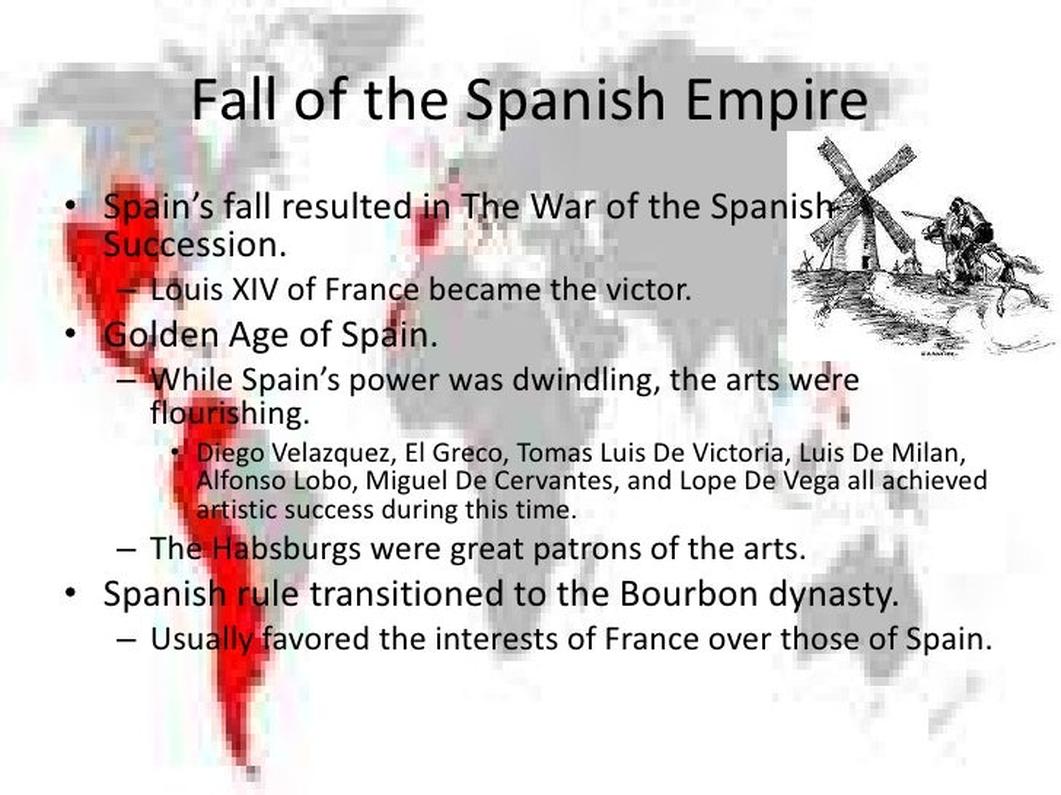
The flood of silver, which once seemed like manna, caused crippling inflation. Spain never grasped that too much silver was bad news. Without strong property rights or political reforms, economic innovation stagnated. The Cortes had little power, and the king’s arbitrary confiscations scared off entrepreneurs.
Unlike England or the Netherlands, Spain failed to cultivate an industrial revolution. Wealth from the colonies was hoarded instead of reinvested in new industries or infrastructure. The economy limped along, propped up by colonial exploitation but vulnerable to shocks.
Constant Warfare: A Draining Marathon
From the 16th century onwards, Spain was almost always at war—whether against the Dutch, the French, the British, or internal rebels. The glory days of military victories gave way to exhaustion. Eventually, the once-mighty Spanish military machine ran out of steam and resources.
Internal Divisions and the Cost of Fragmentation
Spain’s internal fragmentation hampered unification. The kingdoms had their own laws and rulers, and regional identities persisted. The Fueros gave regions like Catalonia and the Basque Country a degree of self-rule, complicating efforts to centralize the state.
This patchwork governance created inefficiencies and fueled local resentment, sometimes sparking revolts. A stronger, more cohesive state might have resisted foreign and domestic pressures better.
Byzantine Bureaucracy: When Red Tape Becomes a Noose

Spain’s bureaucracy was notoriously complicated. It could function under savvy, forceful monarchs. But under weaker leadership, it bogged down decision-making and adaptation. Inflexibility became a hallmark of Spanish governance, frustrating reforms that might have saved the day.
The Fall of Naval Supremacy: Trafalgar and the British Takeover
The Spanish Armada’s failure in 1588 was the first warning that Spanish naval power was contested. However, it was the Battle of Trafalgar in 1805 that truly marked Britain’s domination of the seas. The Spanish fleet, now allied with French forces, was decimated, paving the way for centuries of British maritime supremacy.
Extractive Systems and Elite Control
Underlying much of Spain’s decline was an extractive system funneling wealth to the monarchy and elite circles. Most of the population saw little benefit. The economy and political power were tightly controlled rather than shared or developed equitably. This fueled corruption, inefficiency, and social unrest.
In Conclusion: The Slow Fall of a Once Mighty Empire
Spain’s fall is no sudden disaster. It is a layered, multi-century saga fueled by a mix of overextended wars, economic complacency from resource wealth, rigid trade controls, internal strife, and failed reforms.
It’s a cautionary tale of how riches from conquest can become a poison if not paired with solid internal development and good governance. No empire is invincible—Spain’s story reminds us that even giants can crumble without adaptability and unity.
So next time you wonder, how did Spain fall so hard?—remember it wasn’t one tough blow but a marathon of missteps, challenges, and missed opportunities.
Why did the Eighty Years’ War weaken Spain so much?
The war drained Spain’s finances and military. They went bankrupt multiple times. Losing the Dutch independence showed the world Spain was not invincible.
How did Spain’s reliance on American gold affect its economy?
Spain depended on gold and silver from colonies instead of building industries. This caused economic stagnation and corruption, as effort focused on getting riches rather than creating trade or manufacturing.
What impact did the expulsion of Jews and Muslims have on Spain?
This removal caused loss of skilled artisans and traders. Many who managed economic activities were gone, weakening the economy and reducing economic vitality and expertise.
How did Spain’s internal conflicts contribute to its decline?
Spain fought external wars while facing revolts in Catalonia and Portugal. These simultaneous conflicts drained resources and attention, accelerating decline.
Did Spain recover after the 17th-century decline? Why did it fall again?
Spain briefly recovered in the 18th century. But after allying with France against Britain and losing wars, France invaded Spain. They lost colonies and fell into debt again, weakening their global power.
